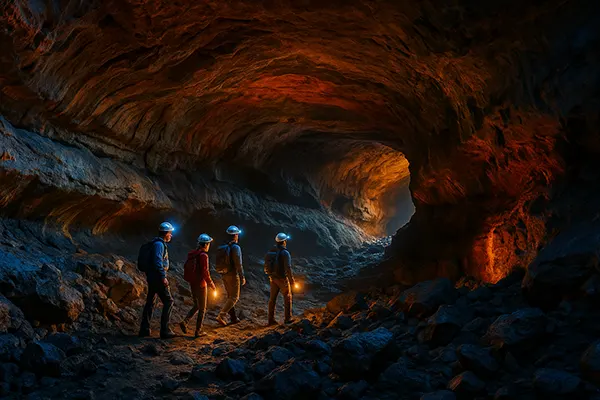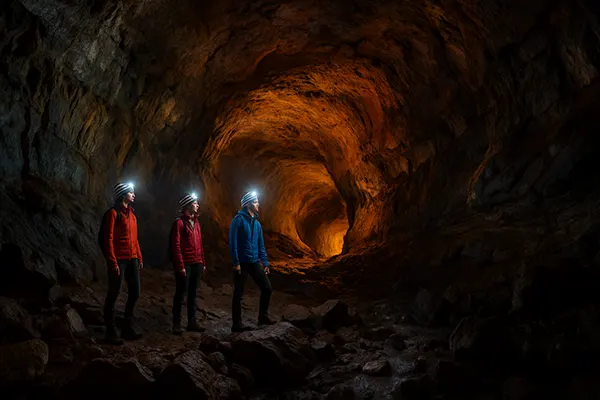
Volcanic Caves of Europe: New Tours and Archaeological Discoveries
Europe’s volcanic caves offer more than natural beauty – they are gateways into ancient worlds and unique geological phenomena. In recent years, geotourism in volcanic regions has gained popularity, drawing explorers, historians, and eco-travellers. From lava tubes formed thousands of years ago to sites revealing Celtic and Roman heritage, volcanic caves are becoming significant cultural and scientific landmarks.
Geological Wonders Beneath Europe
The volcanic caves of La Palma in the Canary Islands have recently been opened to wider tourism. Among the most accessible is Cueva de Todoque, a long lava tunnel formed by the island’s frequent eruptions. These caves not only offer insights into geological processes but also remain untouched by modern development, preserving rare subterranean ecosystems.
In Iceland, Raufarhólshellir stands out as one of the country’s longest lava tubes. Stretching over 1,300 metres, it showcases extraordinary rock formations and colourful mineral deposits. With guided tours now available year-round, it is one of the safest ways for travellers to experience Iceland’s volcanic interior without the need for technical caving skills.
Meanwhile, Italy’s Etna region has begun promoting lesser-known lava caves around the volcano. These include Grotta dei Lamponi and Grotta del Gelo, each revealing the long-lasting effects of lava flow and glaciation. The caves’ microclimates also serve as field sites for biological and climate research.
Scientific Value and Exploration
These subterranean spaces offer scientists opportunities to study volcanic activity over time. Rock layers, mineral compositions, and even residual gases provide data on past eruptions, helping to refine prediction models for future seismic events. Furthermore, the insulation properties of lava tubes make them ideal for studying climate anomalies preserved underground.
Recent collaborations between geologists and archaeologists have led to new discoveries in these cave networks. Tools, pottery shards, and burial markers found in the lava tunnels of La Palma and the Azores point to ancient use by indigenous populations. These findings challenge earlier assumptions that such areas were uninhabitable.
In Iceland, speleologists continue to map unmapped segments of cave systems using LIDAR technology. These efforts have increased the known cave length by 15% in 2024 alone, suggesting that many more kilometres remain hidden beneath the surface.
Archaeological Insights and Cultural Heritage
Beyond geological interest, some volcanic caves serve as key archaeological sites. In western Europe, caves in volcanic terrain near Clermont-Ferrand, France, have revealed Gallo-Roman artefacts such as coins, fibulae, and agricultural tools. These remnants illustrate the blend of Roman engineering and local tradition in the region’s development.
In northern Spain, excavations in the Cueva de los Moros – a lava cave located near Vitoria – uncovered Celtic-era altars carved into basalt walls. Carbon dating places these engravings to around the 5th century BCE, offering rare glimpses into religious rites practised in hidden chambers away from Roman influence.
Portugal’s Azorean archipelago has added new listings to its heritage register. Algar do Carvão, already known for its lava chimney and underground lake, was recently found to contain fragments of ceramic vessels linked to early settlers. Preservation efforts are now underway to protect these finds from tourist-related wear.
Balancing Access and Conservation
Increasing interest in cave tourism brings concerns about damage and sustainability. Many countries have introduced quotas, requiring permits or limiting group sizes. Iceland, for instance, only allows licensed guides to lead groups into Raufarhólshellir, while Italy monitors access with digital visitor counters.
To further conservation efforts, several caves have installed artificial walkways and soft lighting systems. These adjustments reduce physical impact on delicate formations and avoid disturbing local bat populations. In La Palma, interpretive signs along cave routes educate visitors on respecting underground biodiversity.
Conservation groups also advocate for greater public funding for monitoring and maintenance. In France, partnerships between academic institutions and local governments have led to joint research and preservation projects, ensuring both scientific and tourism interests are served responsibly.

Planning a Visit: Tips for Travellers
Volcanic caves are rewarding destinations, but travellers must plan carefully. First and foremost, safety gear is essential. Helmets, headlamps, and sturdy hiking boots are standard; in some caves, gloves and knee protection may also be necessary. Temperatures underground remain low, so warm layers are recommended even in summer.
Most caves now offer guided tours for different experience levels. Beginners are encouraged to start with short tours (under 1 hour), while more adventurous routes may require crawling, climbing, or rappelling. Check in advance whether tours are seasonal – many caves in northern Europe close in winter due to ice buildup and safety concerns.
Finally, respect local rules and customs. Some caves have spiritual or historical significance to nearby communities. Avoid touching formations, stay within marked paths, and follow your guide’s instructions at all times. This ensures both personal safety and long-term preservation of these irreplaceable sites.
Recommended Routes and Locations
Top destinations for 2025 include the Grotta di Santa Ninfa in Sicily, known for its intricate volcanic rock patterns and fossil finds. Another favourite is the Grjótagjá cave in Iceland, famous for its geothermal water and historical significance during the country’s independence movement.
Travellers to Spain should not miss the La Palma Cave Trail, which links five volcanic caves over 6 kilometres. This route includes interpretive stations and panoramic viewpoints along the volcanic ridge. In France, the Auvergne Volcano Park now features an updated volcanic cave circuit with interactive educational exhibits for families.
For the well-prepared explorer, these sites represent a unique way to engage with Earth’s dynamic past. With proper planning and respect for the natural environment, volcanic caves offer insight, adventure, and meaningful connection to European heritage.
